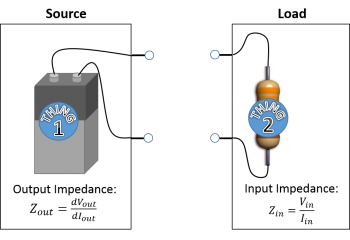Input and output impedance
Overview
What happens when we connect one circuit component to another? Sometimes the circuit component doesn't behave in the same way when it is by itself versus when it is connected to another component. To understand how the circuit will behave, we must consider the input and output impedances of the different parts. The output impedance refers to the impedance, or opposition to current flow, of the component bearing the electrical source. Meanwhile, the input impedance refers to the load component's opposition to current flowing in from the electrical source. In general, you will want to have a high input impedance relative to output impedance, and you will see why in the following sections.
Battery example
Let's look at an example of connecting a battery to a resistor. When we see a 9V battery, we often think it should output 9V from its terminals. It truly does, but only when it's not sourcing any current. It turns out that there is some internal impedance inside the battery that prevents the output voltage from remaining at 9V once current starts to flow. We can thus model the battery as a pure voltage source in series with a resistor, where the resistance value $ R_{out} $ is equal to the output impedance of the battery. Here is an example of a 9V battery's I-V curve (current-voltage relationship).


